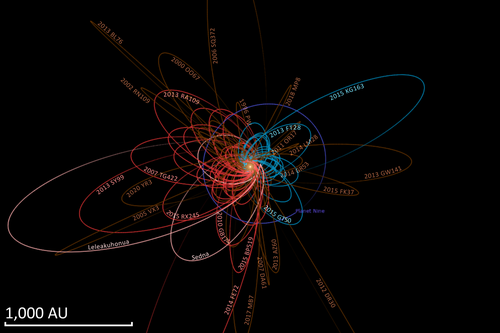| Discovery[1] | |
|---|---|
| Discovered by | Mt. Lemmon Survey |
| Discovery date | 10 January 2013 |
| Designations | |
| Orbital characteristics[3] | |
| Epoch 4 September 2017 (JD 2458000.5) | |
| Uncertainty parameter 1 | |
| Observation arc | 5.20 yr |
| Aphelion | 1,116.9 AU (167.09 Tm) (Q) |
| Perihelion | 7.920 AU (1.1848 Tm) (q) |
| 562 AU (84.1 Tm) (a) | |
| Eccentricity | 0.98592 (e) |
| 13339 yr | |
| 0.07458° (M) | |
| 0.000050074°/day (n) | |
| Inclination | 16.532° (i) |
| 349.20° (Ω) | |
| 158.42° (ω) | |
| Known satellites | 0 |
| Jupiter MOID | 2.58 AU (386 Gm) |
| Saturn MOID | 1.20 AU (180 Gm)[4] |
| Physical characteristics | |
| Dimensions | |
| 9.39±0.22 h[6] | |
| 0.029[6] | |
| 19.8 | |
| 10.2[4][3] | |
2013 AZ60 is a small Solar System body (extended centaur)[4] from the scattered disk or inner Oort cloud. 2013 AZ60 has the 8th-largest semi-major axis of a minor planet not detected outgassing like a comet[7] (2013 BL76, 2005 VX3 and 2012 DR30 have a larger semi-major axis).
2013 AZ60 came to perihelion in November 2014 at a distance of 7.9 AU from the Sun (inside of the orbit of Saturn). With an absolute magnitude (H) of 10.2,[4] 2013 AZ60 has an estimated diameter of 40 km.[5] Comet Hale–Bopp, which is roughly the same size, was not discovered until it was 7.2 AU from the Sun and had started outgassing CO. 2013 AZ60 may be discovered to be cometary as it comes to perihelion. It comes to opposition at the start of April.
After leaving the planetary region of the Solar System, 2013 AZ60 will have a barycentric aphelion of 827 AU with an orbital period of 8500 years. In a 10 million year integration of the orbit, one of the 3-sigma clones is ejected from the Solar System.[2]
| Orbital evolution | |||||||
| Epoch | Barycentric Aphelion (Q) (AU) |
Orbital period yr | |||||
|---|---|---|---|---|---|---|---|
| 1950 | 1261 | 16000 | |||||
| 2050 | 827 | 8500 | |||||
YouTube Encyclopedic
-
1/1Views:1 330
-
Breaking Comet ISON ENCKE And LOVE JOY NEWS
Transcription
Physical characteristics and orbit
A 2016 study found 2013 AZ60 to have a comet-like albedo of 2.9% (darker than any other known ejected centaur) and a color typical of D-type asteroids. It is unknown if it is a so-called "super comet" or an extinct comet, considering its large distance from the Sun. It was also determined that 2013 AZ60 has a diameter of 62.3±5.3 kilometers, larger than initially believed. A light curve analysis found it to have a rotation period of 9.39±0.22 hours, typical of asteroids its size. No significant satellites were detected.
It was also found that 2013 AZ60 is on an extremely unstable orbit, with a ~64% chance of being ejected from the Solar system in 1 million years, and a ~25% chance of being ejected in the next 500,000 years, as well as a 4.2% chance of its orbit venturing into the neighborhood of Earth.[6]
Comparison

See also
- 90377 Sedna (relatively large and also distant body)
- List of hyperbolic comets
- Pluto
- 2012 VP113
- List of Solar System objects by greatest aphelion
- Have very large aphelion
References
- ^ "2013 AZ60". Seicchi Yoshida's Home Page. Archived from the original on 22 October 2013. Retrieved 13 July 2013.
- ^ a b Marc W. Buie. "Orbit Fit and Astrometric record for 13AZ60". SwRI – Space Science Department. Archived from the original on 27 March 2016. Retrieved 15 February 2017.
- ^ a b "JPL Small-Body Database Browser: (2013 AZ60)" (last observation: 2016-01-08; arc: 2.99 yr). Jet Propulsion Laboratory. Archived from the original on 12 February 2017. Retrieved 25 March 2016.
- ^ a b c d "2013 AZ60 Orbit". IAU minor planet center. Archived from the original on 15 February 2016. Retrieved 3 February 2018.
- ^ a b "Absolute Magnitude (H)". NASA/JPL. Archived from the original on 2 March 2001. Retrieved 13 October 2013.
- ^ a b c d Pál, Andras (20 July 2016). "Physical properties of the extreme centaur and super-comet candidate 2013 AZ60". Astronomy & Astrophysics. arXiv:1507.05468. doi:10.1051/0004-6361/201526249. S2CID 117686497.
- ^ "JPL Small-Body Database Search Engine: Asteroids and a > 100 (AU)". JPL Solar System Dynamics. Retrieved 13 October 2013.
External links
- 2013 AZ60 Archived 22 October 2013 at the Wayback Machine (Seiichi Yoshida)
- JPL Webcite archive of Epoch 2016-Jan-13 with aphelion (Q) of 1450AU
- 2013 AZ60 at the JPL Small-Body Database
